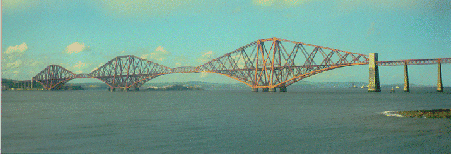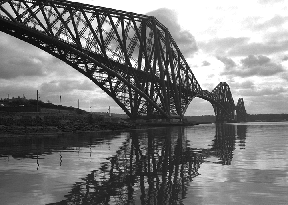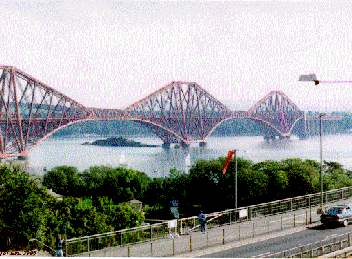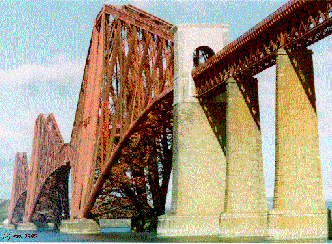The Forth Railway Bridge

In Scotland, one of the most spectacular manmade projects is the Forth railway bridge.
This bridge, of a cantilever type, was operational in 1890. It spans Forth river between
Edinburgh and Dundee, and remains the main railway link over the "Forth".
History
This bridge almost did not see daylight; in fact, when it was
realized that a railway link was
necessary between both shores of river Forth, the solution brought
forward was a tunnel.
After a few studies,this approach was abandoned in 1806 and the idea of
building a bridge was put forward.
In 1818 a few designs were presented, namely the one submitted by
Mr.James Anderson. The structure of the bridge was so light and not
very strong and was described later as " such a light structure that it
would almost have been impossible to see it on a somber day,
and after a strong rainfall, it could not been seen anymore!" In 1865,
a parliament resolution authorized the "North British Railway", and his
engineer
Thomas Bouch, to construct a bridge over the Forth. He proposed a
suspended bridge with twin aprons of 1600 feet each.
Engineer Bouch was also responsible for the bridge construction over
the Tay river, which brough him lots letters of patent nobility.
On the night of 28th. of December 1879, Sir Thomas Bouch received a telegram at his Edinburg house; at this time the bridge over
the Tay river had been in operation for 19 monts. The telegram read as follows:
" Terrible accident on the bridge; one or more girders have
collapsed; do not know the situation concerning the last train from
Edinburgh;
will let you know when other information will be available"
The "Tay Bridge" collapsed during a hurricane and 75 passengers from the Edinburgh train were killed. This was the end
of Sir Bouch's implication in the Forth bridge project, and he died on year later.
The suspended bridge project was also abandoned. Another design was presented and accepted by engineer Benjamin
Baker in 1882. He presented a cantilever bridge structure, a bridge type most popular worldwide.

Realization
The contract for the bridge construction was given on December
21st.1882, and work began by the realization of casings intended to
support the three cantilevers. In 1887, the cantilever arms reached
their intended height and work began to attach them together.
In September 1889, the cantilever arms were almost touching one
another; workers were able with ladders laid flat, to reach accross,
200 feet over the river. On November 6th 1889 the center aprons were
ready to be attached, but they had to wait for the proper weather
to permit the steel to expand for the linkage parts, permitting the
fixation of the aprons to the cantilevers.
The bridge was inaugurated on the 5th. of March 1890. 
Features
This bridge necessitated 54 000 tons of steel, 20 950 cubic metres
of granite, 6 780 cubic metres of stone,
49 200 cubic metres of concrete, 50 tons of cement and 7 millions
rivets. It has a surface of 58 hectares and a height of 137 metres.
The rails that it supports are laid 48 meters over the river; it's
total length is 2530 feet. 57 workers died while building the bridge,
and
4600 workers worked on the bridge at a peak period.
Engineer Benjamin Baker received the "sir" title in 1890. He is also
responsible for the building of the London subway, the transportation
of the Cleopatra obelisk, from Egypt to England. He said about the
Forth Bridge:"If I had pretended that the building of Forth Bridge was
not
a source of constant anxiety, present and future, no experienced
engineer would have believed me. Where there's no precedent, the
engineer who
best succeeded is the one who made the least errors".

Forth Bridge today
Forth Bridge is still nowadays a monument of civil engineering.
Very functionnal, about 200 trains a day travel accross it. What
Scots did concerning this bridge is remarkable. The upkeep was never
neglected with the passing years, which explains it's perfect
conservation since it's construction. It's maintenance budget is 2,2
millions
dollars per year, painting bills representing half of the expenses. A
popular saying is that we will never finish painting it over and over.
In fact, only 90 days are available in the year to execute the work.
Everything is financed by private funds.
Several private companies use the bridge image in order to do their own
sponsoring. For it's 100th anniversary, an architertural lighting was
added:
1054 high pressure sodium lamps and 40 kilometers of cables were used.
44$ an hour is the invoice for lighting the bridge, a lighting
requiring a 300kW power.
A computer system permits to detect defective lamps.
Research done during Summer 1997 by Harold Christensen. Translated by Denis Fortier.
ou




